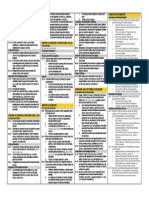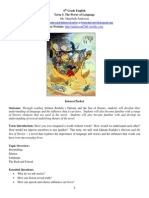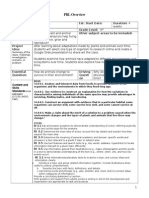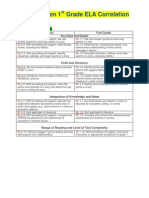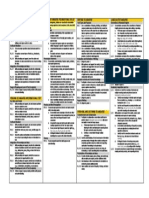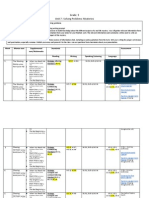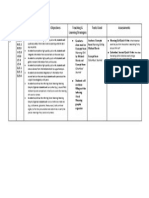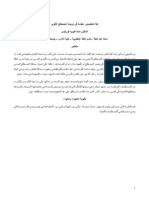3rd Grade Scope and Sequence Final
3rd Grade Scope and Sequence Final
Uploaded by
api-259785027Copyright:
Available Formats
3rd Grade Scope and Sequence Final
3rd Grade Scope and Sequence Final
Uploaded by
api-259785027Original Title
Copyright
Available Formats
Share this document
Did you find this document useful?
Is this content inappropriate?
Copyright:
Available Formats
3rd Grade Scope and Sequence Final
3rd Grade Scope and Sequence Final
Uploaded by
api-259785027Copyright:
Available Formats
Standards Scope and Sequence, Grade 3
Quarter: 1
Unit 1 Unit 2
Reading: Literature
3.RL.1: Ask and answer questions to demonstrate understanding of a text, referring
explicitly to the text as the basis for the answers.
3.RL.2: Recount stories, including fables, folktales, and myths from diverse cultures;
determine the central message, lesson, or moral and explain how it is conveyed through
key details in the text
3.RL.3: Describe characters in a story (e.g., their traits, motivations, or feelings) and explain
how their actions contribute to the sequence of events.
3.RL.4: Determine the meaning of words and phrases as they are used in a text,
distinguishing literal from nonliteral language.
3.RL7: Explain how specific aspects of a texts illustrations contribute to what is conveyed
by the words in a story (e.g., create mood, emphasize aspects of a character or setting).
Reading: Informational Text
3.RI.1: Ask and answer questions to demonstrate understanding of a text, referring
explicitly to the text as the basis for the answers.
3.RI.2: Determine the main idea of a text; recount the key details and explain how they
support the main idea.
3.RI.3: Describe the relationship between a series of historical events, scientific ideas or
concepts, or steps in technical procedures in a text, using language that pertains to
time, sequence, and cause/effect.
3.RI.4: Determine the meaning of general academic and domain-specific words and
phrases in a text relevant to a grade 3 topic or subject area.
3.RI. 7: Use information gained from illustrations (e.g., maps, photographs) and the
words in a text to demonstrate understanding of the text (e.g., where, when, why, and
how key events occur).
Writing: Narrative
3.W.3: Write narratives to develop real or imagined experiences or events using effective
technique, descriptive details, and clear event sequences.
Provide a sense of closure.
3.W.4: With guidance and support from adults, produce writing in which the development
and organization are appropriate to task and purpose.
3.W.5: With guidance and support from peers and adults, develop and strengthen writing
as needed by planning, revising, and editing.
Writing: Narrative
3.W.3: Write narratives to develop real or imagined experiences or events using
effective technique, descriptive details, and clear event sequences.
Provide a sense of closure.
3.W.4: With guidance and support from adults, produce writing in which the
development and organization are appropriate to task and purpose.
3.W.5: With guidance and support from peers and adults, develop and strengthen
writing as needed by planning, revising, and editing.
3.W.6: With guidance and support from adults, use technology to produce and publish
writing (using keyboarding skills) as well as to interact and collaborate with others.
Language
3.L.1: Demonstrate command of the conventions of standard English grammar and usage
when writing or speaking
3.L.2: Demonstrate command of the conventions of standard English capitalization,
punctuation, and spelling when writing.
3.L.5: Demonstrate understanding of word relationships and nuances in word meanings.
3.L.6: Acquire and use accurately grade-appropriate conversational, general academic, and
domain-specific words and phrases, including those that signal spatial and temporal
relationships (e.g., After dinner that night we went looking for them).
Language
3.L.1: Demonstrate command of the conventions of standard English grammar and
usage when writing or speaking
3.L.2: Demonstrate command of the conventions of standard English capitalization,
punctuation, and spelling when writing.
3.L.4: Determine or clarify the meaning of unknown and multiple-meaning word and
phrases based on grade 3 reading and content, choosing flexibly from a range of
strategies.
3.L.6: Acquire and use accurately grade-appropriate conversational, general academic,
and domain-specific words and phrases, including those that signal spatial and temporal
relationships (e.g., After dinner that night we went looking for them).
Standards Scope and Sequence, Grade 3
Quarter: 2
Unit 3 Unit 4
Reading: Literature
3.RL.1: Ask and answer questions to demonstrate understanding of a text, referring
explicitly to the text as the basis for the answers.
3.RL.2: Recount stories, including fables, folktales, and myths from diverse cultures;
determine the central message, lesson, or moral and explain how it is conveyed through
key details in the text
3.RL.5: Refer to parts of stories, dramas, and poems when writing or speaking about a text,
using terms such as chapter, scene, and stanza; describe how each successive part builds
on earlier sections.
3.RL7: Explain how specific aspects of a texts illustrations contribute to what is conveyed
by the words in a story (e.g., create mood, emphasize aspects of a character or setting).
3.RL.9: Compare and contrast the themes, settings, and plots of stories written by the same
author about the same or similar characters (e.g., in books from a series).
Reading: Informational Text
3.RI.1: Ask and answer questions to demonstrate understanding of a text, referring
explicitly to the text as the basis for the answers.
3.RI.2: Determine the main idea of a text; recount the key details and explain how they
support the main idea.
3.RI.5: Use text features and search tools (e.g., key words, sidebars, hyperlinks) to
locate information relevant to a given topic efficiently.
3.RI. 7: Use information gained from illustrations (e.g., maps, photographs) and the
words in a text to demonstrate understanding of the text (e.g., where, when, why, and
how key events occur).
3.RI.9: Compare and contrast the most important points and key details presented in
two texts on the same topic.
Writing: Information/Expository
3.W.2: Write informative/explanatory texts to examine a topic and convey ideas and
information clearly.
Provide a concluding statement or section.
3.W.4: With guidance and support from adults, produce writing in which the development
and organization are appropriate to task and purpose.
3.W.5: With guidance and support from peers and adults, develop and strengthen writing
as needed by planning, revising, and editing.
3.W. 7: Conduct short research projects that build knowledge about a topic.
3.W.8: Recall information from experiences or gather information from print and digital
sources; take brief notes on sources and sort evidence into provided categories.
Writing: Information/Expository
3.W.2: Write informative/explanatory texts to examine a topic and convey ideas and
information clearly.
Provide a concluding statement or section.
3.W.4: With guidance and support from adults, produce writing in which the
development and organization are appropriate to task and purpose.
3.W.5: With guidance and support from peers and adults, develop and strengthen
writing as needed by planning, revising, and editing.
3.W.6: With guidance and support from adults, use technology to produce and publish
writing (using keyboarding skills) as well as to interact and collaborate with others.
3.W. 7: Conduct short research projects that build knowledge about a topic.
3.W.8: Recall information from experiences or gather information from print and digital
sources; take brief notes on sources and sort evidence into provided categories.
Language
3.L.1: Demonstrate command of the conventions of standard English grammar and usage
when writing or speaking
3.L.2: Demonstrate command of the conventions of standard English capitalization,
punctuation, and spelling when writing.
3.L.3: Use knowledge of language and its conventions when writing, speaking, reading, or
listening.
3.L.5: Demonstrate understanding of word relationships and nuances in word meanings.
3.L.6: Acquire and use accurately grade-appropriate conversational, general academic, and
domain-specific words and phrases, including those that signal spatial and temporal
relationships (e.g., After dinner that night we went looking for them).
Language
3.L.1: Demonstrate command of the conventions of standard English grammar and
usage when writing or speaking
3.L.2: Demonstrate command of the conventions of standard English capitalization,
punctuation, and spelling when writing.
3.L.3: Use knowledge of language and its conventions when writing, speaking, reading,
or listening.
3.L.4: Determine or clarify the meaning of unknown and multiple-meaning word and
phrases based on grade 3 reading and content, choosing flexibly from a range of
strategies.
3.L.6: Acquire and use accurately grade-appropriate conversational, general academic,
and domain-specific words and phrases, including those that signal spatial and temporal
relationships (e.g., After dinner that night we went looking for them). (e.g., When other
kids are happy that makes me happy).
Standards Scope and Sequence, Grade 3
Quarter: 3
Unit 5 Unit 6
Reading: Literature
3.RL.1: Ask and answer questions to demonstrate understanding of a text, referring
explicitly to the text as the basis for the answers.
3.RL.2: Recount stories, including fables, folktales, and myths from diverse cultures;
determine the central message, lesson, or moral and explain how it is conveyed through
key details in the text
3.RL.6: Distinguish their own point of view from that of the narra With prompting and
support, describe the relationship between illustrations and the text in which they appear
(e.g., what person, place, thing, or idea in the text an illustration depicts).tor or those of the
characters.
3.RL7: Explain how specific aspects of a texts illustrations contribute to what is conveyed
by the words in a story (e.g., create mood, emphasize aspects of a character or setting).
Reading: Literature
3.RI.1: Ask and answer questions to demonstrate understanding of a text, referring
explicitly to the text as the basis for the answers.
3.RI.2: Determine the main idea of a text; recount the key details and explain how they
support the main idea.
3.RI.6: Distinguish their own point of view from that of the author of a text.
3.RI. 7: Use information gained from illustrations (e.g., maps, photographs) and the
words in a text to demonstrate understanding of the text (e.g., where, when, why, and
how key events occur).
3.RI.8: Describe the logical connection between particular sentences and paragraphs in
a text (e.g., comparison, cause/effect, first/second/third in a sequence).
Writing: Opinion
3..W.1:Write opinion pieces on topics or texts, supporting a point of view with reasons.
3.W.4: With guidance and support from adults, produce writing in which the development
and organization are appropriate to task and purpose.
3.W.5: With guidance and support from peers and adults, develop and strengthen writing
as needed by planning, revising, and editing.
3.W.8: Recall information from experiences or gather information from print and digital
sources; take brief notes on sources and sort evidence into provided categories
Writing: Opinion
3..W.1:Write opinion pieces on topics or texts, supporting a point of view with reasons.
3.W.4: With guidance and support from adults, produce writing in which the
development and organization are appropriate to task and purpose.
3.W.5: With guidance and support from peers and adults, develop and strengthen
writing as needed by planning, revising, and editing.
3.W.6: With guidance and support from adults, use technology to produce and publish
writing (using keyboarding skills) as well as to interact and collaborate with others.
3.W.8: Recall information from experiences or gather information from print and digital
sources; take brief notes on sources and sort evidence into provided categories
Language
3.L.1: Demonstrate command of the conventions of standard English grammar and usage
when writing or speaking
3.L.2: Demonstrate command of the conventions of standard English capitalization,
punctuation, and spelling when writing.
3.L.5: Demonstrate understanding of word relationships and nuances in word meanings.
3.L.6: Acquire and use accurately grade-appropriate conversational, general academic, and
domain-specific words and phrases, including those that signal spatial and temporal
relationships (e.g., After dinner that night we went looking for them).
Language
3.L.1: Demonstrate command of the conventions of standard English grammar and
usage when writing or speaking
3.L.2: Demonstrate command of the conventions of standard English capitalization,
punctuation, and spelling when writing.
3.L.4:Determine or clarify the meaning of unknown and multiple-meaning word and
phrases based on grade 3 reading and content, choosing flexibly from a range of
strategies.
3.L.6: Acquire and use accurately grade-appropriate conversational, general academic,
and domain-specific words and phrases, including those that signal spatial and temporal
relationships (e.g., After dinner that night we went looking for them).
Standards Scope and Sequence, Grade 3
Quarter: 4
Unit 7 Unit 8
Reading: Literature
3.RL.1: Ask and answer questions to demonstrate understanding of a text, referring
explicitly to the text as the basis for the answers.
3.RL.3: Describe characters in a story (e.g., their traits, motivations, or feelings) and explain
how their actions contribute to the sequence of events.
3.RL.4: Determine the meaning of words and phrases as they are used in a text,
distinguishing literal from nonliteral language.
3.RL.5: Refer to parts of stories, dramas, and poems when writing or speaking about a text,
using terms such as chapter, scene, and stanza; describe how each successive part builds
on earlier sections.
Reading: Informational Text
3.RI.1: Ask and answer questions to demonstrate understanding of a text, referring
explicitly to the text as the basis for the answers.
3.RI.3: Describe the relationship between a series of historical events, scientific ideas or
concepts, or steps in technical procedures in a text, using language that pertains to
time, sequence, and cause/effect.
3.RI.4: Determine the meaning of general academic and domain-specific words and
phrases in a text relevant to a grade 3 topic or subject area.
3.RI.5: Use text features and search tools (e.g., key words, sidebars, hyperlinks) to
locate information relevant to a given topic efficiently.
Writing: Narrative
3.W.3: Write narratives to develop real or imagined experiences or events using effective
technique, descriptive details, and clear event sequences.
3.W.4: With guidance and support from adults, produce writing in which the development
and organization are appropriate to task and purpose.
3.W.5: With guidance and support from peers and adults, develop and strengthen writing
as needed by planning, revising, and editing.
Writing: Narrative
3.W.3: Write narratives to develop real or imagined experiences or events using
effective technique, descriptive details, and clear event sequences.
3.W.4: With guidance and support from adults, produce writing in which the
development and organization are appropriate to task and purpose.
3.W.5: With guidance and support from peers and adults, develop and strengthen
writing as needed by planning, revising, and editing.
3.W.6: With guidance and support from adults, use technology to produce and publish
writing (using keyboarding skills) as well as to interact and collaborate with others.
Language
3.L.1: Demonstrate command of the conventions of standard English grammar and usage
when writing or speaking
3.L.2: Demonstrate command of the conventions of standard English capitalization,
punctuation, and spelling when writing.
3.L.5: Demonstrate understanding of word relationships and nuances in word meanings.
3.L.6: Acquire and use accurately grade-appropriate conversational, general academic, and
domain-specific words and phrases, including those that signal spatial and temporal
relationships (e.g., After dinner that night we went looking for them).
Language
3.L.1: Demonstrate command of the conventions of standard English grammar and
usage when writing or speaking
3.L.2: Demonstrate command of the conventions of standard English capitalization,
punctuation, and spelling when writing.
3.L.4: Determine or clarify the meaning of unknown and multiple-meaning word and
phrases based on grade 3 reading and content, choosing flexibly from a range of
strategies.
3.L.6: Acquire and use accurately grade-appropriate conversational, general academic,
and domain-specific words and phrases, including those that signal spatial and temporal
relationships (e.g., After dinner that night we went looking for them).
Taught Year Round
Language Speaking and Listening
L.3.1 Demonstrate command of the conventions of standard English grammar and usage when
writing or speaking.
a. Explain the function of nouns, pronouns, verbs, adjectives, and adverbs in general and their
functions in particular sentences.
b. Form and use regular and irregular plural nouns.
c. Use abstract nouns (e.g., childhood).
d. Form and use regular and irregular verbs.
e. Form and use the simple (e.g., I walked; I walk; I will walk) verb tenses.
f. Ensure subject-verb and pronoun-antecedent agreement.
g. Form and use comparative and superlative adjectives and adverbs, and choose between them
depending on what is to be modified.
h. Use coordinating and subordinating conjunctions.
i. Produce simple, compound, and complex sentences.
L.3.2 Demonstrate command of the conventions of standard English capitalization,
punctuation, and spelling when writing.
a. Capitalize appropriate words in titles.
b. Use commas in addresses.
c. Use commas and quotation marks in dialogue.
d. Form and use possessives.
e. Use conventional spelling for high-frequency and other studied words and for adding suffixes
to base words (e.g., sitting, smiled, cries, happiness)
f. Use spelling patterns and generalizations (e.g., word families, position-based spellings, syllable
patterns, ending rules, meaningful word parts) in writing words.
g. Consult reference materials, including beginning dictionaries, as needed to check and correct
spellings.
L.3.3 Use knowledge of language and its conventions when writing, speaking, reading, or
listening.
a. Choose words and phrases for effect.
b. Recognize and observe differences between the conventions of spoken and written standard
English.
L.3.4 Determine or clarify the meaning of unknown and multiple-meaning word and phrases
based on grade 3 reading and content, choosing flexibly from a range of strategies.
a. Use sentence-level context as a clue to the meaning of a word or phrase.
b. Determine the meaning of the new word formed when a known affix is added to a known
word (e.g., agreeable/disagreeable, comfortable/uncomfortable, care/careless, heat/preheat).
c. Use a known root word as a clue to the meaning of an unknown word with the same root
(e.g., company, companion).
d. Use glossaries or beginning dictionaries, both print and digital, to determine or clarify the
precise meaning of key words and phrases.
L.3.5 Demonstrate understanding of figurative language, word relationships and nuances in
word meanings.
a. Distinguish the literal and nonliteral meanings of words and phrases in context (e.g., take
SL.1.3 Engage effectively in a range of collaborative discussions (one on one, in groups, and
teacher lead) with diverse partners on grade 3 topics and texts, building on others ideas and
expressing their own clearly.
a. Come to discussions prepared
steps).
b. Identify real-life connections between words and their use (e.g., describe people who are
friendly or helpful).
c. Distinguish shades of meaning among related words that describe states of mind or degrees of
certainty (e.g., knew, believed, suspected, heard, wondered).
L.3.6 Acquire and use accurately grade-appropriate conversational, general academic, and
domain- specific words and phrases, including those that signal spatial and temporal
relationships (e.g., After dinner that night we went looking for them).
You might also like
- Jezek, The Lexicon PDFDocument249 pagesJezek, The Lexicon PDFCarolina MarescottiNo ratings yet
- Common Core State Standards For English Language Arts: Grade 3: Reading LiteratureDocument16 pagesCommon Core State Standards For English Language Arts: Grade 3: Reading LiteraturejumpinglotusNo ratings yet
- ReadyGEN Vertical Standards Maps - Grade 3Document12 pagesReadyGEN Vertical Standards Maps - Grade 3Will KirbyNo ratings yet
- Japanese Literature Lesson Plans FinalDocument18 pagesJapanese Literature Lesson Plans Finalapi-210714273100% (1)
- Fourth MO Learning Standards LA1Document4 pagesFourth MO Learning Standards LA1Shawn NguyenNo ratings yet
- Gerunds and InfinitivesDocument5 pagesGerunds and InfinitivesROLANDONo ratings yet
- 3rd Ela PlacematDocument1 page3rd Ela Placematapi-276971164No ratings yet
- Common Core - ELA Standards - NutshellDocument8 pagesCommon Core - ELA Standards - Nutshelldraya3No ratings yet
- Reading Standards For LiteratureDocument9 pagesReading Standards For Literatureapi-290998130No ratings yet
- Grade 3 Scope SequenceDocument9 pagesGrade 3 Scope Sequenceapi-237769293No ratings yet
- Elayear-At-A-Glance 3rdgradebyquarterDocument18 pagesElayear-At-A-Glance 3rdgradebyquarterapi-320723676No ratings yet
- q4 StandardsDocument3 pagesq4 Standardsapi-248799070No ratings yet
- Third Ela StandardsDocument4 pagesThird Ela Standardsapi-233655908No ratings yet
- Ela Grade 3 StandardsDocument6 pagesEla Grade 3 Standardsapi-266473918No ratings yet
- Common Core ELA Grade3 StandardsDocument6 pagesCommon Core ELA Grade3 Standardscflo2100% (1)
- E/LA Common Core Standards For Reading Grade 3: Key Ideas and Details - Anchor StandardsDocument5 pagesE/LA Common Core Standards For Reading Grade 3: Key Ideas and Details - Anchor StandardsPatti Kendrick WhatleyNo ratings yet
- 3rd Grade Standards UnpackedDocument5 pages3rd Grade Standards Unpackedapi-256234399No ratings yet
- StoryTown CC 3 Reverse1Document41 pagesStoryTown CC 3 Reverse1Shirley Fennessey100% (1)
- RMT Grade 3 Learning OutcomesDocument1 pageRMT Grade 3 Learning Outcomesapi-307152920No ratings yet
- Unit 1 Curriculum Map: SurvivalDocument6 pagesUnit 1 Curriculum Map: SurvivalNomadic EdventuresNo ratings yet
- The Boy Who Harnessed The Wind: Lesson PlanDocument9 pagesThe Boy Who Harnessed The Wind: Lesson PlanmahelyNo ratings yet
- 4th q1 Reading-Writing Unit OverviewDocument2 pages4th q1 Reading-Writing Unit Overviewapi-262890220No ratings yet
- 3 Grade Language Arts Common Core Standards: At-A-Glance Reading: LiteratureDocument5 pages3 Grade Language Arts Common Core Standards: At-A-Glance Reading: Literatureapi-298986760100% (1)
- Grade 3 Common CoreDocument12 pagesGrade 3 Common Coreapi-238597060No ratings yet
- Unit - Unit 1 - Rites of PassageDocument21 pagesUnit - Unit 1 - Rites of PassageYasin KhlifiNo ratings yet
- ELA Common Core State Standards and Long-Term Learning Targets Grade 3Document9 pagesELA Common Core State Standards and Long-Term Learning Targets Grade 3api-326474075No ratings yet
- Digital Unit Plan TemplateDocument6 pagesDigital Unit Plan Templateapi-275697087100% (1)
- Unit 1 FinalDocument13 pagesUnit 1 Finalapi-259785027No ratings yet
- Expos1516 Syllcourse TitleDocument5 pagesExpos1516 Syllcourse Titleapi-314677023No ratings yet
- Tnready Blueprint g3 ElaDocument5 pagesTnready Blueprint g3 Elaapi-282869532No ratings yet
- Literacy Unit HeroesDocument4 pagesLiteracy Unit Heroesapi-243600639100% (1)
- 6th Grade Assignment Term 3Document11 pages6th Grade Assignment Term 3api-237229446No ratings yet
- Grade 6 Reading and Literature ObjectivesDocument6 pagesGrade 6 Reading and Literature ObjectivesElvin Junior100% (1)
- 4th Ela StandardsDocument9 pages4th Ela Standardsapi-217895177No ratings yet
- Common Core One Pager Grades 6Document2 pagesCommon Core One Pager Grades 6api-194333853No ratings yet
- 2014-15 SyllabusDocument33 pages2014-15 Syllabusapi-263396905No ratings yet
- Miaa 360 PBL Overview - JMGDocument6 pagesMiaa 360 PBL Overview - JMGapi-268934865No ratings yet
- Lisa Taff, Jessica Mojica, Melissa Sheppard, Ashley: Lesson Plan TemplateDocument7 pagesLisa Taff, Jessica Mojica, Melissa Sheppard, Ashley: Lesson Plan Templateapi-353576849No ratings yet
- Unit Subject Standards BadgesDocument10 pagesUnit Subject Standards Badgescolleen.sNo ratings yet
- Learning Game Lesson PlanDocument7 pagesLearning Game Lesson Planapi-269371029No ratings yet
- Learning CompetenciesDocument5 pagesLearning CompetenciesGracelyn Jhing Racoma CamasuraNo ratings yet
- Kindergarten 1 Grade ELA Correlation: Reading LiteratureDocument8 pagesKindergarten 1 Grade ELA Correlation: Reading Literaturekstone5No ratings yet
- FigPuddingNovelStudyLessonPlan 1Document6 pagesFigPuddingNovelStudyLessonPlan 1Sonia ChowdhariNo ratings yet
- Dornan English Grade 8 Curriculum MapDocument12 pagesDornan English Grade 8 Curriculum Mapapi-340615073100% (1)
- Grade 3: Module 2BDocument967 pagesGrade 3: Module 2BRivka ShareNo ratings yet
- All KDocument3 pagesAll Kapi-250236858No ratings yet
- Grade 4 Common CoreDocument12 pagesGrade 4 Common Coreapi-238597060No ratings yet
- 10-H Curriculum Map - American Literature Semester 1Document9 pages10-H Curriculum Map - American Literature Semester 1hgtfrtgyhuijkmlnbNo ratings yet
- Educ 403, Curriculum Development Ela 3rd GradeDocument31 pagesEduc 403, Curriculum Development Ela 3rd Gradeapi-276583210No ratings yet
- K Ela PlacematDocument1 pageK Ela Placematapi-276971164No ratings yet
- CommoncoreelaDocument1 pageCommoncoreelaapi-289409156No ratings yet
- MemorialDocument18 pagesMemorialS TANCRED100% (2)
- Grade 3: Module 1Document419 pagesGrade 3: Module 1Rivka ShareNo ratings yet
- Fiction Unit - Grade 3 - 2014Document47 pagesFiction Unit - Grade 3 - 2014candy graceNo ratings yet
- Assessment Portfolio - HendersonDocument18 pagesAssessment Portfolio - Hendersonapi-250677904No ratings yet
- Unit 2 - Lesson 1Document17 pagesUnit 2 - Lesson 1Xolani Radebe RadebeNo ratings yet
- 2nd Ela Standards PlacematDocument1 page2nd Ela Standards Placematapi-276971164No ratings yet
- Multiple Intelligences KitDocument4 pagesMultiple Intelligences Kitapi-239394633No ratings yet
- Writing Speculative Fiction: Science Fiction, Fantasy, and Horror: Teacher's EditionFrom EverandWriting Speculative Fiction: Science Fiction, Fantasy, and Horror: Teacher's EditionNo ratings yet
- Applied Linguistics: A Genre Analysis Of: Research Articles Results and Discussion Sections in Journals Published in Applied LinguisticsFrom EverandApplied Linguistics: A Genre Analysis Of: Research Articles Results and Discussion Sections in Journals Published in Applied LinguisticsNo ratings yet
- A Non-Freaked Out Guide to Teaching the Common Core: Using the 32 Literacy Anchor Standards to Develop College- and Career-Ready StudentsFrom EverandA Non-Freaked Out Guide to Teaching the Common Core: Using the 32 Literacy Anchor Standards to Develop College- and Career-Ready StudentsNo ratings yet
- Grade 5 Overviewq 3 Unit 5Document3 pagesGrade 5 Overviewq 3 Unit 5api-259785027No ratings yet
- Grade 1 Unit Doc1updatedDocument6 pagesGrade 1 Unit Doc1updatedapi-259785027No ratings yet
- UnitplantemplateDocument8 pagesUnitplantemplateapi-259785027No ratings yet
- Multiple Main Idea Graphic OrganizerDocument1 pageMultiple Main Idea Graphic Organizerapi-259785027No ratings yet
- Grade 5 Overviewq 4 Unit 7Document3 pagesGrade 5 Overviewq 4 Unit 7api-259785027No ratings yet
- 5thgrade q2 Unit3Document2 pages5thgrade q2 Unit3api-259785027No ratings yet
- Unit 2 Week 4Document1 pageUnit 2 Week 4api-259785027No ratings yet
- Unit 2 Week 1Document1 pageUnit 2 Week 1api-259785027No ratings yet
- Unit 2 Week 3Document1 pageUnit 2 Week 3api-259785027No ratings yet
- Week 3 Unit 1Document1 pageWeek 3 Unit 1api-259785027No ratings yet
- Week1 Unit1Document2 pagesWeek1 Unit1api-259785027No ratings yet
- Week-4 Unit 1Document2 pagesWeek-4 Unit 1api-259785027No ratings yet
- Unit 2 Week 1Document1 pageUnit 2 Week 1api-259785027No ratings yet
- 11-12 Scope and Sequence FinalDocument19 pages11-12 Scope and Sequence Finalapi-259785027No ratings yet
- Finished9-10th Overview FinalDocument2 pagesFinished9-10th Overview Finalapi-259785027No ratings yet
- Prefixes and SuffixesDocument10 pagesPrefixes and SuffixestiaraNo ratings yet
- Unit 3 Town and CountryDocument38 pagesUnit 3 Town and Countrynhatlinh08svlNo ratings yet
- Unlock 2e RW1 Tests Unit 02Document3 pagesUnlock 2e RW1 Tests Unit 02sandyyelithNo ratings yet
- ReportedSpeech Part 2 - VinceDocument4 pagesReportedSpeech Part 2 - VinceadideoNo ratings yet
- Task-Assigment - Week 18 Final Priject - Part II - 601245950Document9 pagesTask-Assigment - Week 18 Final Priject - Part II - 601245950Jesús Alberto Ugaz TorrejónNo ratings yet
- PrayerDocument18 pagesPrayerCandice MakkiNo ratings yet
- Adjective OrderDocument3 pagesAdjective OrderFlor NietoNo ratings yet
- Passive VoiceDocument3 pagesPassive VoicePeterNo ratings yet
- Basic 1, Chapter 1, Lesson 3, Singular and Plural NounsDocument16 pagesBasic 1, Chapter 1, Lesson 3, Singular and Plural NounsLinda MelendezNo ratings yet
- Modal Verbs 2 - Necessity and AdviceDocument4 pagesModal Verbs 2 - Necessity and AdviceperdidalmaNo ratings yet
- Aspect, Tense & Modality (2020)Document10 pagesAspect, Tense & Modality (2020)florencia gomezNo ratings yet
- ﻟﻐﺔ اﻟﺘﺨﺼﺺ: ﻣﻘﺪﻣﺔ ﻓﻲ ﺗﺮﺟﻤﺔ اﻟﻤﺼﻄﻠﺢ اﻟﱡﻐﻮيDocument15 pagesﻟﻐﺔ اﻟﺘﺨﺼﺺ: ﻣﻘﺪﻣﺔ ﻓﻲ ﺗﺮﺟﻤﺔ اﻟﻤﺼﻄﻠﺢ اﻟﱡﻐﻮيDinha GorgisNo ratings yet
- Intermediate Unit 2aDocument2 pagesIntermediate Unit 2agallipatero100% (3)
- ENG 0999 Summer 2023 Wk1 NOUNS and Articles 2Document31 pagesENG 0999 Summer 2023 Wk1 NOUNS and Articles 2Mehvish ShaikhNo ratings yet
- Worksheet Unit 7bDocument2 pagesWorksheet Unit 7bMayra Sofia Rojas HuamaniNo ratings yet
- 5953 23053 3 PBDocument7 pages5953 23053 3 PBPutri MahzuniNo ratings yet
- The Simple PresentDocument3 pagesThe Simple PresentVianey FigueroaNo ratings yet
- Mastermind 1 Practice OnlinexDocument9 pagesMastermind 1 Practice OnlinexGrecia Ugarte ArchondoNo ratings yet
- What We Learned:: Face2Face Intermediate Unit 11 Homework and Language SummaryDocument2 pagesWhat We Learned:: Face2Face Intermediate Unit 11 Homework and Language Summarybndgdd cncncjNo ratings yet
- Paper de Energías RenovablesDocument12 pagesPaper de Energías RenovablesCarlos JavierNo ratings yet
- Fill in The Gaps. Use Don't or Doesn'tDocument7 pagesFill in The Gaps. Use Don't or Doesn'tjenny pechoNo ratings yet
- Word WizardDocument6 pagesWord Wizardbblawson210No ratings yet
- How To Speak English Well: 10 Simple Tips To Extraordinary FluencyDocument3 pagesHow To Speak English Well: 10 Simple Tips To Extraordinary FluencyRifNo ratings yet
- PhrasesDocument91 pagesPhrasesfceducation052No ratings yet
- Possessive CaseDocument8 pagesPossessive CaseOrtiz MaritzaNo ratings yet
- Structure Skills 13-14Document5 pagesStructure Skills 13-14Muhammad rafiNo ratings yet
- Bach (2004) - Minding The GapDocument17 pagesBach (2004) - Minding The GapTomas CastagninoNo ratings yet






